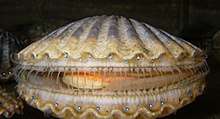Spontaneous generation
Spontaneous generation is a body of thought on the ordinary formation of living organisms without descent from similar organisms. The theory of spontaneous generation held that living creatures could arise from nonliving matter and that such processes were commonplace and regular. It was hypothesized that certain forms such as fleas could arise from inanimate matter such as dust, or that maggots could arise from dead flesh.[1] A variant idea was that of equivocal generation, in which species such as tapeworms arose from unrelated living organisms, now understood to be their hosts. The idea of univocal generation, by contrast, refers to effectively exclusive reproduction from genetically related parent(s), generally of the same species.
The doctrine of spontaneous generation was coherently synthesized by Aristotle,[2] who compiled and expanded the work of earlier natural philosophers and the various ancient explanations for the appearance of organisms, and was taken as scientific fact for two millennia. Though challenged in the 17th and 18th centuries by the experiments of Francesco Redi and Lazzaro Spallanzani, spontaneous generation was not disproved until the work of Louis Pasteur and John Tyndall in the mid-19th century.[3]

Rejection of spontaneous generation is no longer controversial among biologists. By the middle of the 19th century, experiments by Louis Pasteur and others refuted the traditional theory of spontaneous generation and supported biogenesis.[4][5][6]
Description and terminology
Spontaneous generation refers both to the supposed processes by which different types of life might repeatedly emerge from specific sources other than seeds, eggs, or parents, and also to theoretical principles presented in support of any such phenomena. Crucial to this doctrine are the ideas that life comes from non-life and that no causal agent, such as a parent, is needed. The hypothetical processes by which life routinely emerges from nonliving matter on a time scale of minutes, weeks, or years (e.g. in the supposed seasonal generation of mice and other animals from the mud of the Nile) are sometimes referred to as abiogenesis.[7] Such ideas have no operative principles in common with the modern hypothesis of abiogenesis, which asserts that life emerged in the early ages of the planet, over a time span of at least millions of years, and subsequently diversified, and that there is no evidence of any subsequent repetition of the event.[8]
The term equivocal generation, sometimes known as heterogenesis or xenogenesis, describes the supposed process by which one form of life arises from a different, unrelated form, such as tapeworms from the bodies of their hosts.[9]
In the years following Louis Pasteur's 1859 experiment, the term "spontaneous generation" fell increasingly out of favor. Experimentalists used a variety of terms for the study of the origin of life from nonliving materials. Heterogenesis was applied to the generation of living things from once-living organic matter (such as boiled broths), and Henry Charlton Bastian proposed the term archebiosis for life originating from inorganic materials. Disliking the randomness and unpredictability implied by the term "'spontaneous' generation," in 1870 Bastian coined the term biogenesis to refer to the formation of life from nonliving matter. Soon thereafter, however, English biologist Thomas Henry Huxley proposed the term abiogenesis to refer to this same process and adopted biogenesis for the process by which life arises from existing life; it is this latter set of definitions that became dominant.[10]
Antiquity
Presocratic philosophers
Active in the 6th and 5th centuries BCE, early Greek philosophers, called physiologoi in antiquity (Greek: φυσιολόγοι; in English, physical or natural philosophers), attempted to give natural explanations of phenomena that had previously been ascribed to the agency of the gods.[11] The physiologoi sought the material principle or arche (Greek: ἀρχή) of things, emphasizing the rational unity of the external world and rejecting theological or mythological explanations.[12]
Anaximander, who believed that all things arose from the elemental nature of the universe, the apeiron (ἄπειρον) or the "unbounded" or "infinite," was likely the first western thinker to propose that life developed spontaneously from nonliving matter. The primal chaos of the apeiron, eternally in motion, served as a substratum in which elemental opposites (e.g., wet and dry, hot and cold) generated and shaped the many and varied things in the world.[13] According to Hippolytus of Rome in the third century CE, Anaximander claimed that fish or fish-like creatures were first formed in the "wet" when acted on by the heat of the sun and that these aquatic creatures gave rise to human beings.[14] Censorinus, writing in the 3rd century, reports:
Anaximander of Miletus considered that from warmed up water and earth emerged either fish or entirely fishlike animals. Inside these animals, men took form and embryos were held prisoners until puberty; only then, after these animals burst open, could men and women come out, now able to feed themselves.[15]
Anaximenes, a pupil of Anaximander, thought that air was the element that imparted life and endowed creatures with motion and thought. He proposed that plants and animals, including human beings, arose from a primordial terrestrial slime, a mixture of earth and water, combined with the sun's heat. Anaxagoras, too, believed that life emerged from a terrestrial slime. However, he held that the seeds of plants existed in the air from the beginning, and those of animals in the aether. Xenophanes traced the origin of man back to the transitional period between the fluid stage of the earth and the formation of land, under the influence of the sun.[16]
In what has occasionally been seen as a prefiguration of a concept of natural selection,[17] Empedocles accepted the spontaneous generation of life but held that different forms, made up of differing combinations of parts, spontaneously arose as though by trial and error: successful combinations formed the species we now see, whereas unsuccessful forms failed to reproduce.
Aristotle
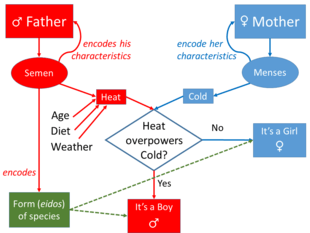
In his biological works, the natural philosopher Aristotle theorized extensively the reproduction of various animals, whether by sexual, parthenogenetic, or spontaneous generation. In accordance with his fundamental theory of hylomorphism, which held that every physical entity was a compound of matter and form, Aristotle's basic theory of sexual reproduction contended that the male's seed imposed form, the set of characteristics passed down to offspring on the "matter" (menstrual blood) supplied by the female. Thus female matter is the material cause of generation—it supplies the matter that will constitute the offspring—while the male semen is the efficient cause, the factor that instigates and delineates the thing's existence.[18] Yet, as proposed in the History of Animals, many creatures form not through sexual processes but by spontaneous generation:
Now there is one property that animals are found to have in common with plants. For some plants are generated from the seed of plants, whilst other plants are self-generated through the formation of some elemental principle similar to a seed; and of these latter plants some derive their nutriment from the ground, whilst others grow inside other plants ... So with animals, some spring from parent animals according to their kind, whilst others grow spontaneously and not from kindred stock; and of these instances of spontaneous generation some come from putrefying earth or vegetable matter, as is the case with a number of insects, while others are spontaneously generated in the inside of animals out of the secretions of their several organs.[20]
— Aristotle, History of Animals, Book V, Part 1
According to this theory, living things may come forth from nonliving things in a manner roughly analogous to the "enformation of the female matter by the agency of the male seed" seen in sexual reproduction.[19] Nonliving materials, like the seminal fluid present in sexual generation, contain pneuma (πνεῦμα, "breath"), or "vital heat". According to Aristotle, pneuma had more "heat" than regular air did, and this heat endowed the substance with certain vital properties:
The power of every soul seems to have shared in a different and more divine body than the so called [four] elements ... For every [animal], what makes the seed generative inheres in the seed and is called its "heat." But this is not fire or some such power, but instead the pneuma that is enclosed in the seed and in foamy matter, this being analogous to the element of the stars. This is why fire does not generate any animal ... but the heat of the sun and the heat of animals does, not only the heat that fills the seed, but also any other residue of [the animal's] nature that may exist similarly possesses this vital principle.
Aristotle drew an analogy between the "foamy matter" (τὸ ἀφρῶδες) found in nature and the "seed" of an animal, which he viewed as being a kind of foam itself (composed, as it was, from a mixture of water and pneuma). For Aristotle, the generative materials of male and female animals (semen and menstrual blood) were essentially refinements, made by male and female bodies according to their respective proportions of heat, of ingested food, which was, in turn, a byproduct of the elements earth and water. Thus any creature, whether generated sexually from parents or spontaneously through the interaction of vital heat and elemental matter, was dependent on the proportions of pneuma and the various elements which Aristotle believed comprised all things.[22] While Aristotle recognized that many living things emerged from putrefying matter, he pointed out that the putrefaction was not the source of life, but the byproduct of the action of the "sweet" element of water.[23]
Animals and plants come into being in earth and in liquid because there is water in earth, and air in water, and in all air is vital heat so that in a sense all things are full of soul. Therefore living things form quickly whenever this air and vital heat are enclosed in anything. When they are so enclosed, the corporeal liquids being heated, there arises as it were a frothy bubble.
— Aristotle, Generation of Animals, Book III, Part 11
With varying degrees of observational confidence, Aristotle theorized the spontaneous generation of a range of creatures from different sorts of inanimate matter. The testaceans (a genus which for Aristotle included bivalves and snails), for instance, were characterized by spontaneous generation from mud, but differed based upon the precise material they grew in—for example, clams and scallops in sand, oysters in slime, and the barnacle and the limpet in the hollows of rocks.[20]
Latin and early Christian sources
Vitruvius, a Roman architect and writer of the 1st century BCE, advised that libraries be placed facing eastwards to benefit from morning light, but not towards the south or the west as those winds generate bookworms.[24]
Aristotle claimed that eels were lacking in sex and lacking milt, spawn and the passages for either.[25] Rather, he asserted eels emerged from earthworms.[26] Later authors dissented. Pliny the Elder did not argue against the anatomic limits of eels, but stated that eels reproduce by budding, scraping themselves against rocks, liberating particles that become eels.[27] Athenaeus described eels as entwining and discharging a fluid which would settle on mud and generate life. On the other hand, Athenaeus also dissented towards spontaneous generation, claiming that a variety of anchovy did not generate from roe, as Aristotle stated, but rather, from sea foam.[28]
As the dominant view of philosophers and thinkers continued to be in favour of spontaneous generation, some Christian theologians accepted the view. Augustine of Hippo discussed spontaneous generation in The City of God and The Literal Meaning of Genesis, citing Biblical passages such as "Let the waters bring forth abundantly the moving creature that hath life" (Genesis 1:20) as decrees that would enable ongoing creation.[29]
Middle Ages
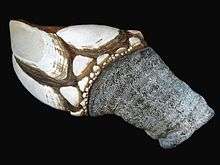
Pollicipes cornucopia
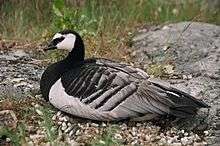
Branta leucopsis
From the fall of the Roman Empire in 5th century to the East-West Schism in 1054, the influence of Greek science declined, although spontaneous generation generally went unchallenged. New descriptions were made. Of the numerous beliefs, some had doctrinal implications outside of the Book of Genesis. For example, the idea that a variety of bird known as the barnacle goose emerged from a crustacean known as the goose barnacle, had implications on the practice of fasting during Lent. In 1188, Gerald of Wales, after having traveled in Ireland, argued that the "unnatural" generation of barnacle geese was evidence for the virgin birth.[30] Where the practice of fasting during Lent allowed fish, but prohibited fowl, the idea that the goose was in fact a fish suggested that its consumption be permitted during Lent. The practice was eventually prohibited by decree of Pope Innocent III in 1215.[31]
Aristotle, in Latin translation, from the original Greek or from Arabic, was reintroduced to Western Europe. During the 13th century, Aristotle reached his greatest acceptance. With the availability of Latin translations Saint Albertus Magnus and his student, Saint Thomas Aquinas, raised Aristotelianism to its greatest prominence. Albert wrote a paraphrase of Aristotle, De causis et processu universitatis, in which he removed some and incorporated other commentaries by Arabic scholars.[32] The influential writings of Aquinas, on both the physical and metaphysical, are predominantly Aristotelian, but show numerous other influences.[33]
Spontaneous generation is discussed as a fact in literature well into the Renaissance. Where, in passing, Shakespeare discusses snakes and crocodiles forming from the mud of the Nile (Ant 2.7 F1), Izaak Walton again raises the question of the origin of eels "as rats and mice, and many other living creatures, are bred in Egypt, by the sun's heat when it shines upon the overflowing of the river...". While the ancient question of the origin of eels remained unanswered and the additional idea that eels reproduced from corruption of age was mentioned, the spontaneous generation of rats and mice engendered no debate.[34]
The Dutch biologist and microscopist Jan Swammerdam (1637–1680) rejected the concept that one animal could arise from another or from putrification by chance because it was impious and like others found the concept of spontaneous generation irreligious, and he associated it with atheism and Godless opinion.[35]
Modern tests
Jan Baptist van Helmont (1580–1644) used experimental techniques, such as growing a willow for five years and showing it increased mass while the soil showed a trivial decrease in comparison. As the process of photosynthesis was not understood, he attributed the increase of mass to the absorption of water.[36] His notes also describe a recipe for mice (a piece of soiled cloth plus wheat for 21 days) and scorpions (basil, placed between two bricks and left in sunlight). His notes suggest he may even have done these things.[37]
Where Aristotle held that the embryo was formed by a coagulation in the uterus, William Harvey (1578–1657) by way of dissection of deer, showed that there was no visible embryo during the first month.[38] Although his work predated the microscope, this led him to suggest that life came from invisible eggs. In the frontispiece of his book Exercitationes de Generatione Animalium (Essays on the Generation of Animals), he made an expression of biogenesis: "omnia ex ovo" (everything from eggs).[29]
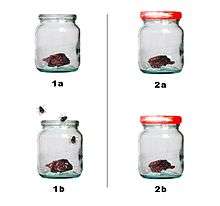
The ancient beliefs were subjected to testing. In 1668, Francesco Redi challenged the idea that maggots arose spontaneously from rotting meat. In the first major experiment to challenge spontaneous generation, he placed meat in a variety of sealed, open, and partially covered containers.[39] Realizing that the sealed containers were deprived of air, he used "fine Naples veil", and observed no worm on the meat, but they appeared on the cloth.[40] Redi used his experiments to support the preexistence theory put forth by the Church at that time, which maintained that living things originated from parents.[41] In scientific circles Redi's work very soon had great influence, as evidenced in a letter from John Ray in 1671 to members of the Royal Society of London:
Whether there be any spontaneous or anomalous generation of animals, as has been the constant opinion of naturalists heretofore, I think there is good reason to question. It seems to me at present most probable, that there is no such thing; but that even all insects are the natural issue of parents of the same species with themselves. F. Redi has gone a good way in proving this, having cleared the point concerning generation ex materia putrida. But still there remain two great difficulties. The first is, to give an account of the production of insects bred in the by-fruits and excrescencies of vegetables, which the said Redi doubts not to ascribe to the vegetative soul of the plant that yields those excrescencies. But for this I refer you to Mr. Lister. The second, to render an account of insects bred in the bodies of other animals. I hope shortly to be able to give you an account of the generation of some of those insects which have been thought to be spontaneous, and which seem as unlikely as any to be after the ordinary and usual way.[42]
Pier Antonio Micheli, around 1729, observed that when fungal spores were placed on slices of melon the same type of fungi were produced that the spores came from, and from this observation he noted that fungi did not arise from spontaneous generation.[43]
In 1745, John Needham performed a series of experiments on boiled broths. Believing that boiling would kill all living things, he showed that when sealed right after boiling, the broths would cloud, allowing the belief in spontaneous generation to persist. His studies were rigorously scrutinized by his peers and many of them agreed.[39]
Lazzaro Spallanzani modified the Needham experiment in 1768, attempting to exclude the possibility of introducing a contaminating factor between boiling and sealing. His technique involved boiling the broth in a sealed container with the air partially evacuated to prevent explosions. Although he did not see growth, the exclusion of air left the question of whether air was an essential factor in spontaneous generation.[39] However, by that time there was already widespread scepticism among major scientists, to the principle of spontaneous generation. Observation was increasingly demonstrating that whenever there was sufficiently careful investigation of mechanisms of biological reproduction, it was plain that processes involved basing of new structures on existing complex structures, rather from chaotic muds or dead materials. Joseph Priestley, after he had fled to America and not long before his death, wrote a letter that was read to the American Philosophical Society in 1803. It said in part:
There is nothing in modern philosophy that appears to me so extraordinary, as the revival of what has long been considered as the exploded doctrine of equivocal, or, as Dr. Darwin calls it, spontaneous generation; by which is meant the production of organized bodies from substances that have no organization, as plants and animals from no pre-existing germs of the same kinds, plants without seeds, and animals without sexual intercourse. The germ of an organized body, the seed of a plant, or the embrio of an animal, in its first discoverable state, is now found to be the future plant or animal in miniature, containing every thing essential to it when full grown, only requiring to have the several organs enlarged, and the interstices filled with extraneous nutritious matter. When the external form undergoes the greatest change, as from an aquatic insect to a flying gnat, a caterpillar to a crysalis, a crysalis to a butterfly, or a tadpole to a frog, there is nothing new in the organization; all the parts of the gnat, the butterfly, and the frog, having really existed, though not appearing to the common observer in the forms in which they are first seen. In like manner, every thing essential to the oak is found in the acorn.[44]
In 1837, Charles Cagniard de la Tour, a physicist, and Theodor Schwann, one of the founders of cell theory, published their independent discovery of yeast in alcoholic fermentation. They used the microscope to examine foam left over from the process of brewing beer. Where Leeuwenhoek described "small spheroid globules", they observed yeast cells undergo cell division. Fermentation would not occur when sterile air or pure oxygen was introduced if yeast were not present. This suggested that airborne microorganisms, not spontaneous generation, was responsible.[45]
However, although the idea of spontaneous generation had been in decline for nearly a century, its supporters did not abandon it all at once. As James Rennie wrote:
...inability to trace the origin of minute plants and insects led to the doctrine of what is called spontaneous or equivocal generation, of which the fancies above-mentioned are some 'of the prominent branches. The experiments of Redi on the hatching of insects from eggs, which were published at Florence in 1668, first brought discredit upon this doctrine, though it had always a few eminent disciples. At present it is maintained by a considerable number -of distinguished naturalists, such as Blumenbach, Cuvier, Bory de St. Vincent, R. Brown, &c. "The notion or spontaneous generation," says Bory, " is at first revolting to a rational mind, but it is, notwithstanding, demonstrable by the microscope. The fact is averred : Willer has seen it, I have seen it, and twenty other observers have seen it: the pandorinia exhibit it every instant. "These pandorinia he elsewhere describes as probably nothing more than " animated scions of Zoocarpae". It would be unprofitable to go into any lengthened discussion upon this mysterious subject; and we have great doubts whether the ocular demonstration by the microscope would succeed except in the hands of a disciple of the school. Even with naturalists, whose business it is to deal with facts, the reason is often wonderfully influenced by the imagination...[46]
Pasteur and Tyndall
Louis Pasteur's 1859 experiment is widely seen as having settled the question of spontaneous generation.[47] He boiled a meat broth in a swan neck flask. The bend in the neck of the flask prevented falling particles from reaching the broth, while still allowing the free flow of air. The flask remained free of growth for an extended period. When the flask was turned so that particles could fall down the bends, the broth quickly became clouded.[39] However, minority objections were persistent and not always unreasonable, given that the experimental difficulties were far more challenging than the popular accounts suggest. The investigations of John Tyndall, a correspondent of Pasteur and a great admirer of Pasteur's work, were decisive in disproving spontaneous generation and dealing with lingering issues. Still, even Tyndall encountered difficulties in dealing with the effects of microbial spores, which were not well understood in his day. Like Pasteur, he boiled his cultures to sterilize them, and some types of bacterial spores can survive boiling. The autoclave, which eventually came into universal application in medical practice and microbiology to sterilise equipment, was not an instrument that had come into use at the time of Tyndall's experiments, let alone those of Pasteur.[3]
In 1862, the French Academy of Sciences paid a special attention to the issue and established a prize "to him who by well-conducted experiments throws new light on the question of the so-called spontaneous generation" and appointed a commission to judge the winner.[48]
See also
- Bugonia or bougonia
References
- Ball, Philip (2016). "Man Made: A History of Synthetic Life". Distillations. 2 (1): 15–23. Retrieved 22 March 2018.
- Brack, André (1998). "Introduction" (PDF). In Brack, André (ed.). The Molecular Origins of Life. Cambridge University Press. p. 1. ISBN 978-0-521-56475-5.
Aristotle gathered the different claims into a real theory.
- Tyndall, John; Fragments of Science, Vol 2, chapters IV, XII (1876), XIII(1878); Pub. P. F. Collier, New York 1905; (Available at: https://archive.org/details/fragmenoscien02tyndrich)
- Zubay, Geoffrey. Origins of Life, Second Edition: On Earth and in the Cosmos. Academic Press 2000. ISBN 978-0127819105
- Smith, John Maynard; Szathmary, Eors (1997). The Major Transitions in Evolution. Oxford: Oxford University Press. ISBN 978-0198502944.
- Levine, Russell and Evers, Chris (1999)."The Slow Death of Spontaneous Generation".The National Health Museum.
- Stillingfleet, Edward. Origines Sacrae. Cambridge University Press 1697. May be downloaded from
- Bernal, J. D. (1967) [Reprinted work by A. I. Oparin originally published 1924; Moscow: The Moscow Worker]. The Origin of Life. The Weidenfeld and Nicolson Natural History. Translation of Oparin by Ann Synge. London: Weidenfeld & Nicolson. LCCN 67098482.CS1 maint: ref=harv (link)
- Wiener, Philip P., ed. (1973). "Spontaneous Generation". Dictionary of the History of Ideas. New York: Charles Scribner's Sons. Retrieved 2009-01-22.
- Strick, James (April 15, 2001). "Introduction". Evolution & The Spontaneous Generation. Continuum International Publishing Group. pp. xi–xxiv. ISBN 978-1-85506-872-8. Retrieved August 27, 2012.
- Guthrie, William Keith Chambers, The Presocratic Tradition from Parmenides to Democritus, p. 13, ISBN 0-317-66577-4.
- Seyffert, Oskar (1894), Dictionary of Classical Antiquities, page 480
- Curd, Patricia (1998). The Legacy of Parmenides: Eleatic Monism and Later Presocratic Thought. Princeton University Press. p. 77. ISBN 0-691-01182-6.
- Kahn, Charles H. (1994). Anaximander and the Origins of Greek Cosmology. Hackett Publishing. p. 247. ISBN 0872202550.
- Censorinus, De Die Natali, IV, 7
- Osborn, Henry Fairfield (1894). From the Greeks to Darwin: An outline of the development of the evolution idea. New York: Macmillan.
- Zirkle, Conway (1941). "Natural Selection before the "Origin of Species"". Proceedings of the American Philosophical Society. 84 (1): 71–123.
- Leroi, Armand Marie (2014). The Lagoon: How Aristotle Invented Science. Bloomsbury. pp. 215–221. ISBN 978-1-4088-3622-4.
- Lehoux, Daryn (2017). Creatures Born of Mud and Slime: The Wonder and Complexity of Spontaneous Generation. Baltimore: Johns Hopkins University Press. p. 22.
- Aristotle (1910) [c. 343 BCE]. "Book V". History of Animals. translated by D'Arcy Wentworth Thompson. Oxford: Clarendon Press. ISBN 90-6186-973-0. Retrieved 2008-12-20.
- Lehoux, Daryn (2017). Creatures Born of Mud and Slime: The Wonder and Complexity of Spontaneous Generation. Baltimore: Johns Hopkins University Press. p. 23.
- Lehoux, Daryn (2017). Creatures Born of Mud and Slime. 26–28: Johns Hopkins University Press.CS1 maint: location (link)
- Aristotle (1912) [c. 350 BCE]. "Book III". On the Generation of Animals. translated by Arthur Platt. Oxford: Clarendon Press. ISBN 90-04-09603-5. Retrieved 2009-01-09.
- Marcus Vitruvius Pollio (1826) [c. 25 BCE]. "Part 4". In Joseph Gwilt (translator) (ed.). On Architecture (de Architectura). Book VI. electronic format by Bill Thayer. London: Priestley and Weale. Retrieved 2009-02-03.
- Aristotle (1910) [c. 343 BCE]. "Book IV". The History of Animals. translated by D'Arcy Wentworth Thompson. Oxford: Clarendon Press. ISBN 90-6186-973-0. Retrieved 2008-12-20.
- Aristotle (1910) [c. 343 BCE]. "Book VI". The History of Animals. translated by D'Arcy Wentworth Thompson. Oxford: Clarendon Press. ISBN 90-6186-973-0. Retrieved 2008-12-20.
- Gaius Plinius Secundus (1855) [c. 77]. "74. (50.) — The generation of fishes". In John Bostock, Henry Thomas Riley (ed.). Natural History. BOOK IX. The natural history of fishes. Retrieved 2009-02-03.
- Athenaeus of Naucratis. "Book VII". In Yonge, C.D. (ed.). The deipnosophists, or, Banquet of the learned of Athenæus. University of Wisconsin Digital Collection. I. London: Henry G. Bohn. pp. 433–521. Retrieved 2009-02-03.
- Fry, Iris (2000). "Chapter 2: Spontaneous Generation — Ups and Downs". The Emergence of Life on Earth. Rutgers University Press. ISBN 978-0-8135-2740-6. Retrieved 2009-01-21.
- Giraldus Cambrensis (1188). Topographia Hiberniae. ISBN 0-85105-386-6. Retrieved 2009-02-01.
- Lankester, Sir Edwin Ray (1970) [1915]. "XIV. The History of the Barnacle and the Goose". Diversions of a Naturalist (illustrated ed.). Ayer Publishing. pp. 117–128. ISBN 978-0-8369-1471-9. Retrieved 2009-02-01.
- Zalta, Edward N., ed. (March 20, 2006). "Albert the Great". Stanford Encyclopedia of Philosophy (Winter 2009 ed.). Stanford, CA: The Metaphysics Research Lab. ISBN 1-158-37777-0. OCLC 179833493. Retrieved 2009-01-23.
- Zalta, Edward N., ed. (July 12, 1999). "Saint Thomas Aquinas". Stanford Encyclopedia of Philosophy (Winter 2009 ed.). Stanford, CA: The Metaphysics Research Lab (published January 9, 2005). ISBN 1-158-37777-0. OCLC 179833493. Retrieved 2009-01-23.
- Walton, Izaak (1903) [1653]. "XIII. Observations of the eel, and other fish that want for scales, and how to fish for them". The Compleat Angler or the Contemplative Man's Recreation. transcribed by Risa Bear. George Bell & Sons. ISBN 0-929309-00-6. Retrieved 2009-02-05.
- Osler, Margaret J.; Farber, Paul Lawrence (22 August 2002). Religion, Science, and Worldview: Essays in Honor of Richard S. Westfall. Cambridge University Press. pp. 230–. ISBN 978-0-521-52493-3. Retrieved 15 August 2012.
- Ducheyne, Steffen (2006). "Joan Baptista van Helmont and the Question of Experimental Modernism" (PDF). pp. 305–332. Retrieved 2009-01-07.
- Pasteur, Louis (April 23, 1864). Latour, Bruno (ed.). "Des générations spontanées" (PDF). 1. Conférences faite aux "soirées scientifiques de la Sorbonne" (published 1993 (English translation)): 257–265. Archived from the original (PDF) on March 26, 2009. Retrieved 2009-01-07. Cite journal requires
|journal=(help); Check date values in:|publication-date=(help) - Magner, Lois; Lerner, K. Lee. "Embryology – History Of Embryology As A Science". Retrieved 2009-01-09.
- Levine, Russell; Evers, Chris (1999). "The Slow Death of Spontaneous Generation (1668–1859)". Washington, D.C.: National Health Museum. Retrieved 2008-12-19.
- Redi, Francesco (1909) [1669]. Mab Bigelow (translator) (ed.). Experiments on the Generation of Insects. Chicago: Open Court. Retrieved 2008-12-19.
Francesco Redi experiment.
- Fry, Iris (1 February 2000). Emergence of Life on Earth: A Historical and Scientific Overview. Rutgers University Press. pp. 27–. ISBN 978-0-8135-2740-6. Retrieved 14 October 2012.
- Royal Society (Great Britain); Hutton, Charles, 1737–1823; Shaw, George, 1751–1813; Pearson, Richard, 1765–1836. The Extract of a Letter written by Mr. JOHN RAY, to the Editor, from Middleton, July 3, 1671, concerning Spontaneous Generation;... Number 73, p. 2219. The Philosophical transactions of the Royal Society of London, from their commencement in 1665, in the year 1800. Page 617-618. May be downloaded from:
- Agrios, George N. (2005). Plant Pathology. Academic Press. pp. 17–. ISBN 978-0-12-044565-3. Retrieved 14 August 2012.
- Priestley, Joseph. Observations and Experiments relating to equivocal, or spontaneous, Generation. Transactions of the American Philosophical Society, Volume VI, page 119-129, 1809. Download from:
- Springer, Alfred (October 13, 1892). "The Micro-organisms of the Soil". Nature. Nature Publishing Group. 46 (1198): 576–579. Bibcode:1892Natur..46R.576.. doi:10.1038/046576b0. ISSN 0028-0836.
- Rennie, James. Insect Transformations. Page 10. Pub: Charles Knight 1838 Download from:
- "Pasteur's "col de cygnet" (1859)". www.immunology.org. British Society for Immunology. Retrieved 2019-08-11.
- Engelhardt, Hugo Tristram; Caplan, Arthur L. (1987). Scientific Controversies: Case Studies in the Resolution and Closure of Disputes in Science and Technology. Cambridge University Press. p. 107. ISBN 978-0-521-27560-6.
